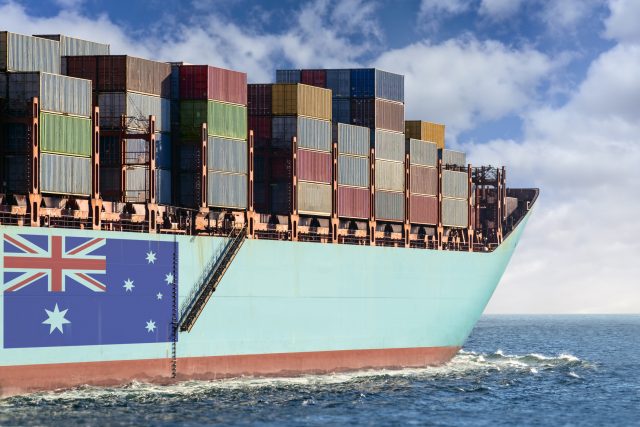China boosts Australian wine exports, but is it enough?
By Eloise FeildenAustralian wine exports jumped 17% in value to AU$2.2 billion in 2023-24 thanks to Chinese tariffs being dropped, but the global outlook paints a less rosy picture.

Australian wine exports increased in value by 17% to AU$2.2 billion in the year to 30 June 2024. This is the highest level since the 12 months ended September 2021, according to Wine Australia’s export report released today.
Export volumes remained relatively steady at 619 million litres, down just 0.2% on last year.
Shipments to China were to thank for the value growth, as Australian wine re-stocked supply pipelines following the removal of the duties on Australian bottled wine in late March 2024. However, the market offers a mixed picture for wine producers Down Under.
Potential in China
Volume exports to the People’s Republic rose from 1 million litres last financial year to 33 million in FY24. Value was up by AU$392m, totalling AU$400m year-on-year.
Growth in the value of Australian wine exports was due to a surge in exports to mainland China in the last three months of the financial year. However, the numbers are still small compared to what they were before the tariffs were ever implemented.
Peter Bailey, Wine Australia manager, market insights, said the rise in exports to mainland China is still a small fraction of historical peaks achieved in the market.
In FY24 Wine Australia recorded 574 companies exporting to mainland China in 2023–24, up from 115 in 2022–23.
However, prior to the imposition of duties, there were more than 2,000 companies exporting to mainland China. In 2023–24, the top ten exporters by value to the market accounted for three-quarters of the total value and 39% of the volume of exports.
The figures are also limited to shipments into the country, and do not reflect consumer sentiment towards Australian wine.
Bailey explained: “While the figures are very positive, they represent the re-stocking of Australian wine in the pipeline of a major market after a long absence and do not necessarily equate to retail sales. It will take some time before there is a clearer picture of how Chinese consumers are responding to the increased availability of Australian wine in-market.”
Consumption of domestic and imported wines in Mainland China is also less than a third of what it was six years ago. Bailey said that in the face of this reality, “it is very unlikely that Australian wine exports will return to those previous peaks in the short to medium term”.
Partner Content
Exports of wine priced at AU$20 or more per litre FOB (free on board) accounted for 84% of the growth, and were the main driver of value growth to mainland China.
Among varieties exported from Australia, still red wine was the main beneficiary of the growth in exports to mainland China, with total volume of red wine up 3 per cent to 330 million litres and value up 27 per cent to $1.5 billion compared to 2022–23. Cabernet Sauvignon grew in value by 41 per cent to $469 million and volume by 12 per cent to 70 million litres, with the US also contributing to the increase in exports of this variety.
“The growth in value has seen mainland China return to the top export market by value,” Mr Bailey said. “However, the volume of exports at 33 million litres, is relatively small, equating to less than 5% of Australia’s wine grape harvest in 2024 and so is unlikely to make a significant impact on the current oversupply of red winegrapes, particularly in the big volume-producing warm inland regions.”
Too much wine
Producers in Riverland in South Australia, the Riverina in NSW, and the Murray Valley in Victoria are all facing financial pressure as a result of supply and demand imbalances.
China’s punitive tariffs were partly responsible for the wine glut, but producers have continued to face issues with oversupply in the years since they were implemented.
In March, Australia’s government implemented a task force to tackle the issue, which in some cases has even hit payment levels last seen in the 1970s.
Global declines
Global exports of Australian wine excluding Mainland China declined by 4% to AU$1.8bn in FY24.
Volume was similarly down 5% to 587m litres, the lowest volume exported to the rest of the world since 2003-04. The decline in volume was most significant in unpackaged exports priced under AU$1.50 per litre to the US and Canada, down a combined 20 million litres, Wine Australia has reported.
Bailey said: “Global trading conditions remain very challenging with wine consumption continuing to fall in many markets around the world due to moderation trends and cost of living pressures. There are also enduring problems in shipping, with a shortage of ships globally and freight and charter rates on the rise.”
In the top five markets by value for Australian wine, exports were up in Mainland China and Hong Kong (+25%), but down in the US (-1%), UK (-3%) and Canada (-11%).
For volume exports, figures were down in four of the five top markets (UK, US, Canada and New Zealand), while volumes were up in Mainland China.
Related news
Will white wine be central to Burgundy's future success in Asia?




